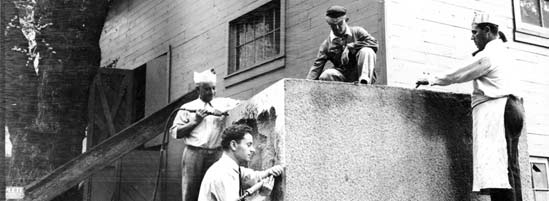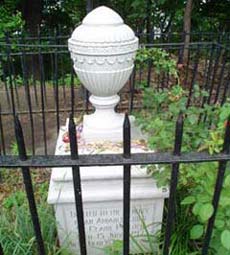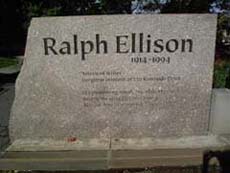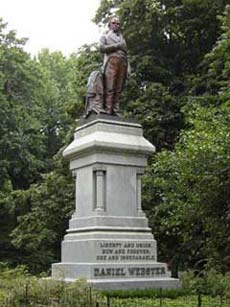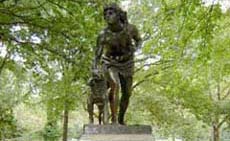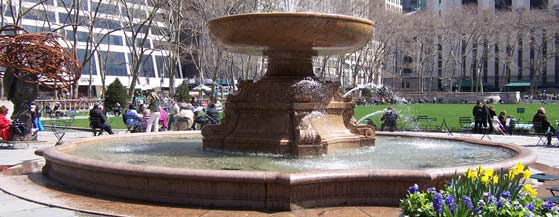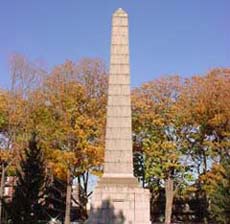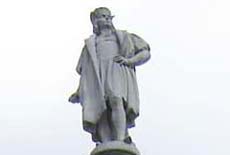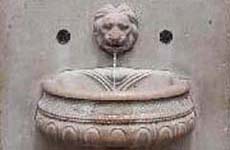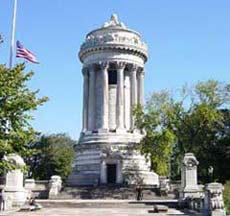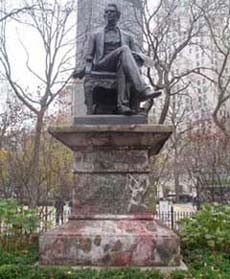To learn more about the Parks-rocks connection be sure to read the companion piece, Hot Rocks: A Geological History of New York City Parks.
Parks Monuments and Geology
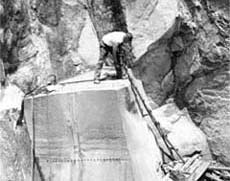
Click on images in the article for a larger view.
Introduction
Monuments and memorials are society’s means of perpetuating memory in a physical format and establishing a forum for permanent commemoration. As such, monuments require materials with lasting properties.
There are three principal types of stone used in the structures, pedestals, and ornament of the many monuments that may be found throughout the parks system: granite, limestone, and marble. To a lesser degree, sandstone and its variants, brownstone and bluestone, have been used as building materials also for ornamental carvings and paving materials.
Rock Compositions
Granite, an igneous rock, is formed through the cooling and crystallization of molten bodies within the earth. It is dense and durable. Limestone is a sedimentary rock comprised mainly of the mineral calcite and formed through the compression of mostly marine organisms in pre-historic times. It can be soft and flinty and porous and, though easy to cut and tool, it is susceptible to weathering from the effects of acid rain and other pollutants. Marble is created through a metamorphic process in which heat and pressure cause the recrystallization of sendimentary carbonate rocks, and is related to limestone. It is often prized for its variegated color and veining, but may also be found in a pure white. Most marble, especially the colorful variety, is actually limestone, though commercial quarries and vendors, unlike geologists, tend to distinguish the two. Marble is also highly vulnerable to damage from weathering and pollutants. As used in monuments, the same granite and marble may have a strikingly different appearance and coloration depending on whether their surface treatment has a flame finish, honed surface, or polished treatment.
This summary features some of the more commonly found types of stone used in the New York City Parks monuments collection. (Please note that there may be more examples than statistically reported, as records and identification for many parks monuments do not record the precise quarry and type.)
Barre Granite
Forty-two park monuments use this versatile stone quarried since 1814 in Barre, Vermont and used for that state’s capital in Montpelier, completed in 1838. Its predominant color is gray. In the City’s parks, its use ranges from the replacement urn for the tomb of the Amiable Child and the marker to the Warsaw Ghetto martyrs, both in Riverside Park, to far-flung pedestals for portrait statuary of president Chester A. Arthur, abolitionist Henry Ward Beecher, General Ulysses S. Grant, industrialist Conrad Poppenhusen, composers George M. Cohan and Carl Maria Von Weber, as well as the iconic Civil War soldier of Central Park’s 7th Regiment Memorial. Barre granite is even used in the bronze marker to Lt. Colonel Isaac Barre that is mounted in City Hall Park.
Deer Isle Granite
One of the earliest uses of this durable stone—quarried since the late 1860s at Deer Isle, Maine and ranging from grays to rose colors—was in the Harvard Bridge across the Charles River. President John F. Kennedy’s memorial at Arlington National Cemetery, as well as the Robert F. Kennedy (formerly Triborough) Bridge and Rockefeller Center, all make use of Deer Isle granite. In New York City’s parks some 43 monuments incorporate Deer Isle stone, ranging from the modest Bowdoin horse trough in Central Park and Jerry McAuley drinking fountain in Greeley Square, to the engraved “cheek” walls of the memorial to Ralph Ellison in Riverside Park and the massive Doric column of Fort Greene’s Prison Ship Martyrs Monument.
Quincy Granite
Quincy granite was quarried in many locations as early as 1745. One of the larger quarries opened in Quincy, Massachusetts in the early 19th century, and the prevalence of this stone expanded measurably in 1825 with its use in the Bunker Hill Monument. The last quarry producing this dense speckled blue-gray stone closed in 1963, but not before 19 New York City parks monuments featured it. These include portrait statues of Robert Fulton, Daniel Webster, Major General Hancock, General Edward Fowler, Samuel Morse, the Marquis de Lafayette (the Union Square version, where the elegant incised decoration contrasts with the stone’s high polish), Roscoe Conkling, and two of Horace Greeley. The stone is used in the massive obelisk at Fifth Avenue and Broadway’s crossing that honors Major General Worth, and the Wireless Operators monument in Battery Park. Central Park’s oldest bronze sculpture, Eagles and Prey, cast in 1850, was mounted on a setting of Quincy granite in 1863, and the Fort Washington Monument in Bennett Park makes effective decorative use of the visual contrast between this granite with other stones and metals.
Rockport Granite
First excavated in 1823 at Rockport on the Cape Ann coast of Massachusetts, this dense gray or greenish-gray stone has been used in six park monuments, including several early sculptures and decorative features in Central Park, among them the Indian Hunter and William Shakespeare sculptures and the decorative urns in the concert ground area of the Mall.
Stony Creek Granite
Located in Branford, Connecticut, the Stony Creek quarry traces its origins to 1858, just before the Civil War. The richly textured pinkish granite, flecked or streaked with black, was used to construct the Brooklyn Bridge piers and the pedestal of the Statue of Liberty. In recent years, a revival of interest in this stone saw its use to clad Philip Johnson’s AT & T (now Sony Corporation) “Chippendale”-topped tower on Madison Avenue in midtown Manhattan, as well as on the main World Financial Center buildings at Battery Park City, designed by Cesar Pelli. Stony Creek granite is also used for street curbs in the mid-Manhattan 34th Street Partnership business improvement district.
In the City’s parks, Stony Creek granite is used in 15 monuments, including the Samuel Tilden sculpture and terrace, Saint-Gaudens' famous equestrian portrait of General William Tecumseh Sherman, the Josephine Shaw Lowell fountain in Bryant Park, the Discus Thrower on Randall’s Island, and the beloved Mother Goose and Hans Christian Andersen children’s statues in Central Park.
Westerly Granite
Westerly granite is a pinkish or buff medium gray stone. Some varieties are blue while others have a red tinge speckled with black. When polished, it assumes a much darker hue. It was quarried in Rhode Island from the 1840s to the 1950s. More than 30 sculptures on the facade of the old Surrogate Courthouse (in 2009 the home of the Department of Cultural Affairs and the Department of Records and Information Services) are carved from Westerly granite, while 18 monuments in the City’s parks make use of this stone. They range from a modest mile marker at the Morris-Jumel Mansion to the massive Dover Patrol monument in Brooklyn, and the granite is used in several older portrait sculptures in Central Park, such as Samuel Morse, Alexander Von Humboldt, Giuseppe Mazzini, and Richard Morris Hunt.
Indiana Limestone
Quarrying of Indiana limestone began in 1827, and this cream-colored stone has been one of the most prevalent used in the United States. By 1900, Indiana limestone represented one-third of the nation’s limestone production, and though production has subsided since its heights, even in 2009 nine active quarries produce 76,000 cubic meters a year. The quarrying operation figures prominently in the plot of the 1979 film, Breaking Away.
In New York City, Indiana limestone has been used in several notable landmarks, including the Empire State Building, the Flatiron Building, and the General Electric building at Rockefeller Center. More than 30 statues on the facade of the Brooklyn Museum use Indiana limestone, and 36 monuments in New York City’s parks employ the stone, including the low relief, WPA-era animal sculptures at the Central Park and Prospect Park zoos, the Macombs Dam Fountain, and Riverdale Bell Tower (lower story and ornamental trim) in the Bronx, and the impressive pedestals for the Panthers sculptures framing the third street entrance at Prospect Park.
Carrara Marble
Though there are many kinds of Carrara marble, the one which has established its fame is a statuary virtually pure white marble, quarried for thousands of years since the ancient Roman Empire in Tuscany in northwest Italy, and associated with the pinnacle of Renaissance statuary, in particular Michelangelo's David sculpture. Its use in New York’s parks has been limited to four monuments, three of which have an Italian association--the monument to composer Giuseppe Verdi at Verdi Square, the statue of Columbus in Columbus Circle, and a portrait bust of Columbus in D’Auria Murphy Park in the Bronx.
Tennessee Marble
This off-white pinkish rock commonly referred to as Tennessee Marble is actually a limestone that has been quarried since 1838 from the Appalachians of eastern Tennessee. Though used sparingly in our parks, this attractive stone is used in six monuments of significance, including the Firemen’s Memorial on Riverside Drive, the Maine Monument at Columbus Circle, the Major General Clarence Barrett Memorial on Staten Island, and the memorial to the victims of the General Slocum steamship disaster in Tompkins Square Park. The famous lions, Patience and Fortitude, which stand as guardians at the entrance of the New York Public Library’s central branch, are also carved from Tennessee pink marble.
Vermont Marble
Vermont marble was used as early as 1785, and the first commercial quarry in Dorset is said to be perhaps the first quarry in North America. The stone is a chalky white lent texture by various golden, dark blue-gray, and green veining, and one of its more substantial uses was in the construction of New York City’s central library building designed by Carrere and Hastings and completed in 1911. Quarries producing the Danby and Dorset varieties of Vermont marble continue to this day, though its use has been limited in New York City’s parks, from the very modest (and perhaps oldest native monument) Fort George marker in Battery Park to the lavish Soldiers and Sailors Memorial at Riverside Park.
Special Cases
Certain notable monuments in the New York City parks collection are unique in their use of a given stone. Some examples include the Washington Square Arch (Tuckahoe Marble for the structure, Dover marble for the statuary); the ancient Egyptian obelisk in Central Park known as Cleopatra’s Needle (granite quarried in Aswan, Egypt); the Emma Lazarus and Jerusalem Grove markers in Battery Park, both which use limestone from Israel; the lovely basin of the Firemen’s Memorial made of Pompton Lakes granite; the original striated, fragile Red Levante or Rosso Levanto Italian marble (replaced with more durable Brazilian Red Arno granite in 2019) supporting William Seward’s statue in Madison Square Park; and the ancient limestone monument, known as the Column of Jerash, built by the ancient Romans and a gift of the Kingdom of Jordan for the New York World’s Fair of 1964-65 held in Flushing Meadows Corona Park. Several historic cemeteries may also be found in the parks of New York; their monuments of marble, and on occasion those of sandstone, exhibit the weathering typically consistent with the adverse effects of acid rain on such stones.
Read more about the Parks-rocks connection in Hot Rocks: A Geological History of New York City Parks.
